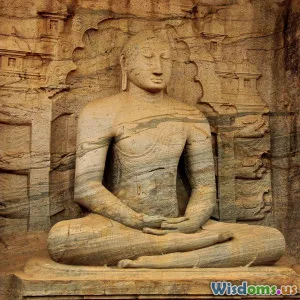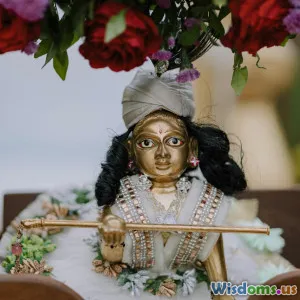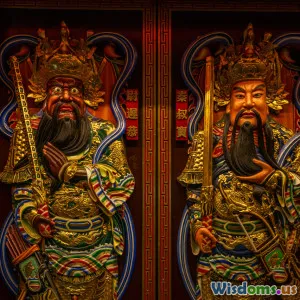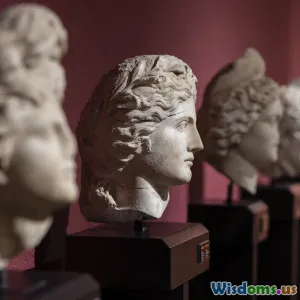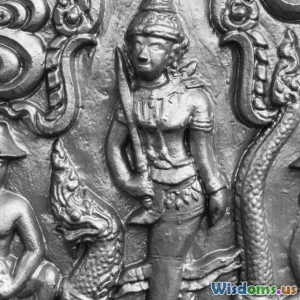
Debunking Common Myths About Hindu Deities
16 min read Explore fact-based insights debunking widespread misconceptions about Hindu deities, revealing the depth and diversity of Hindu mythology. (0 Reviews)
Debunking Common Myths About Hindu Deities
Introduction: Unveiling the Misunderstood Divine
Despite being one of the oldest living religions, Hinduism and its deities are often misinterpreted—sometimes misrepresented—in mainstream conversations. Hindu mythology, with its pantheon of vibrant and diverse deities, is brimming with stories and symbolism. However, these are frequently distilled into simplistic caricatures or misunderstood ideas. From colorful festival posters to social media memes, Hindu gods and goddesses are subject to various misconstrued notions. But what if our most ingrained beliefs about these deities are actually wide of the mark?
In this article, we will pierce through lingering myths and misconceptions about Hindu deities, examine their complexity, explore the realities behind their representations, and discover the deeper meanings encoded within their stories. Equipped with historical facts, real-world examples, and insights from scholars, you'll find yourself viewing Hindu deities from a fresh, authentic perspective—one that honors their true essence and the wisdom encoded in their myths.
The Roots of Common Myths
How Misconceptions Arise
Understanding the origin of these myths is the first step to clearing them up. Some misconceptions stem from:
- Language Barriers: Ancient scriptures such as the Vedas and Puranas were written in Sanskrit, a language not widely known today. Translations and interpretations often introduce errors or oversimplifications.
- Colonial Narratives: British colonial scholars, like James Mill, misunderstood Hindu philosophy, painting deities as “idols” rather than multifaceted representations.
- Popular Culture: Comics, movies, and festivals depict gods and goddesses in simplified, colorful forms, divorcing them from their philosophic depth.
A 2018 survey by Pew Research Center found that less than 30% of non-Hindus in the United States felt familiar with Hindu beliefs. Stereotypes and generalized images fill these gaps, fueling new myths or reinforcing old ones.
Myth #1: Hinduism Has Millions of Gods
The Truth: A Polymorphic Monotheism
A commonly cited number claims Hinduism has 330 million gods. This often leads to the misconception that Hindus worship countless, competing gods in a polytheistic chaos. In fact, the reality is more subtle and sophisticated.
Historical Context:
- The Rigveda (one of Hinduism’s oldest texts) describes the “One Truth (Ekam Sat), which sages call by many names.”
- The symbolic number 33 crore (330 million) refers not to actual counted gods, but as a poetic representation of the infinite faces and forms that divinity can assume.
Monotheism or Polytheism?
- Practically, Hinduism is monotheistic at its core, positing Brahman—one ultimate reality/consciousness—as the source of all. Deities like Vishnu, Shiva, or Devi are distinct aspects (or avatars) of the single Brahman.
- This is captured in the analogy of the sun: it appears different when shining on a river, sea, or puddle, yet is the same sunlight.
Scholar’s Insight: Dr. Anantanand Rambachan, Professor of Religion, writes, “The multiple deities are not competing gods but windows into the one divine reality, experienced in diverse ways.”
Real-World Examples
- Many Hindus begin prayers with invocations to both a personal deity (e.g., Krishna) and an abstract formless reality (Brahman).
- In different regions, the same deity is worshipped in different forms: Karthikeya in Tamil Nadu is Murugan, in North India he is Skanda.
Bottom Line: Hinduism’s large number of deities represents the countless ways the divine can be experienced, not discrete, rival entities.
Myth #2: Idol Worship is Blind Ritualism
The Truth: Murti as a Means, Not an End
Many non-Hindus—and even some Hindus unfamiliar with philosophical background—assume that icon worship is blind superstition.
Contextual Reality:
- Murtis (images) serve as symbols—vivid reminders to focus the mind and heart. The practice is called "Murti Puja."
- The Bhagavad Gita (Chapters 12 and 14) clarifies that worship can be directed to both a concrete form and an abstract reality.
Analogies & Facts:
- Just as photographs evoke memories of loved ones but are not confused for the people themselves, murtis function as points of connection.
- Sri Ramakrishna, the 19th-century mystic, said, “When you worship the image, you are worshipping God Himself. ... The image is a symbol; God Himself is present there.”
Symbolic Power:
- Rituals, chants, and offerings center the mind—akin to meditation with objects or icons in other traditions (think of Catholic saints and icons, or Tibetan mandalas).
Modern Example
- Across the global Hindu diaspora—from Mauritius to California—temples serve as cultural and spiritual hubs, with murtis as focal points that unify both tradition and community engagement.
Takeaway: Icon worship in Hinduism is a deeply philosophical, mindful practice—not blind ritualism.
Myth #3: Hindu Deities are Only “Mythical” or Fantastical
The Truth: Deities are Archetypes of Human and Cosmic Principles
Calling Hindu gods “mythical” often implies they are invented, escapist fiction. Yet, these deities function more like Jungian archetypes or symbolic representations of forces within the universe and human psyche.
Examples:
- Durga: Embodies Shakti (dynamic energy). She is the psychological and cosmic principle of resilience and righteous force.
- Ganesha: Lord of beginnings and remover of obstacles. Walter Andersen, a noted political scientist, calls Ganesha worship “a way to engage in self-purification and resolve to overcome difficulties.”
- Krishna: More than a cowherd hero, Krishna encapsulates divine play, loving wisdom, and the integration of worldly joy with spiritual awakening (as shown in the Bhagavad Gita and Bhagavata Purana).
Real-Life Examples:
- During Durga Puja in Kolkata, much of the legendary goddess’s narrative is retold in plays and street art as inspiration for overcoming social injustices.
- Near Mumbai, entrepreneurs organize Ganesh Chaturthi to coincide with business openings as a symbolic call for new beginnings and clear paths ahead.
Quote: Swami Vivekananda wrote, “Each deity is but a symbol of a universal law. ... Each represents an aspect of the Infinite.”
Conclusion: Hindu deities are timeless symbols for universal ideals—not just characters in ancient fairy tales.
Myth #4: Hindu Goddesses Depict Patriarchy and Oppressed Women
The Truth: The Centrality of the Divine Feminine in Hinduism
Many are surprised to learn how profoundly the divine feminine is embedded in Hindu thought. Yet, Western depictions often suggest gods assume male power while goddesses are subordinate.
Historical Overview:
- Goddesses like Saraswati (learning), Lakshmi (wealth), and Kali (destruction and rebirth) embody essential, revered cosmic energies.
- The concept of “Shakti” places feminine energy at the very center of creation. In Shakta traditions and texts such as the Devi Mahatmya, the goddess is unmistakably credited as the origin and sustaining force of the universe.
Modern Manifestations:
- Festivals like Navaratri (Nine Nights of the Goddess) draw millions, celebrating feminine power. For nine nights, most Hindu homes and temples are centered on Durga or her variants.
- In Kerala’s Attukal Bhagavathy festival, up to 3 million women gather annually—the largest gathering of women for a single religious event, globally (Guinness World Records, 2009).
Cultural Impact:
- Devotees frequently regard the mother goddess as the “supreme reality”—a framework unique among the world's great religions.
- Ancient Tamil literature (like the Sangam texts) highlights queen and female warriors esteemed for their valor—often with goddess-like attributions.
Insight: As Tracey Pintchman, Professor of Religious Studies, notes, “Hindu goddesses are often more authoritative, active, and independent than their male consorts.”
Result: Far from supporting patriarchal submission, Hinduism elevates the feminine as vital and, at times, supreme in its cosmogony.
Myth #5: Deities are Just Linked to Specific Castes or Regions
The Truth: Universal Archetypes Crossing All Boundaries
The notion that deities only belong to certain castes, tribes, or geographies is misleading. Hindu mythology abounds with stories reflecting diversity and inclusivity.
Historical Examples:
- Bhakti Movement: In medieval India, poet-saints from all castes (including so-called “untouchables” like Chokhamela) worshipped deities such as Krishna or Shiva, composing devotional poetry.
- Jagannath of Puri: Worshipped by all, the deity’s forms are intentionally abstract and non-anthropomorphic so everyone can identify, regardless of status.
Pan-Indian Presence:
- South India’s Madurai—known for Goddess Meenakshi—attracts devotees from around the world, not just Tamils.
- Venkateswara (Tirupati Bala Ji) is central for North and South Indians alike, receiving millions of visitors yearly (over 30 million in 2019).
Cross-Cultural Spread:
- The worship of Ganesha, originally regional to Maharashtra, has spread globally, with temples from Canada to Cambodia.
Lesson: Hindu deities represent universal ideals and aspirations—transcending narrow divisions.
Myth #6: Hindu Deities Demand Fear and Blind Obedience
The Truth: Relationship Over Dogma
Unlike the rigid, contract-based deity-worship seen in some traditions, Hindu gods model rich, personal relationships—often flexible and rooted in love.
Multiple Paths of Devotion:
- Bhakti (Love and Surrender): Many Hindu texts, such as the Bhagavata Purana, emphasize loving surrender—where devotees relate to deities as a parent, friend, beloved, or child.
- Jñana (Knowledge): Some worship through contemplation, studying symbolic stories and engaging the intellect.
- Karma (Action): Some express devotion through ethical living and service.
Ramayana and Mahabharata:
- Stories of Hanuman illustrate selfless loyalty; Draupadi’s devotion to Krishna demonstrates the promise that the divine responds to sincere calls for help, not fearful ritual.
Modern Example:
- ISKCON and other groups promote communal singing (kirtan) and group study, emphasizing joy, camaraderie, and collective service rather than supplication out of dread.
Philosophical Standpoint:
- The Upanishads and the Gita strongly advocate for “freedom to approach the divine in the manner the heart desires.”
- As Eknath Easwaran, author and teacher, put it: “Every relationship is a way to reach the same divine center.”
Takeaway: Hinduism encourages varied, heartfelt relationships with deities, focusing on internal growth rather than blind fear.
Myth #7: Hindu Deities Are Unchanging and Permanent Figures
The Truth: Mythology That Evolves
Unlike religious traditions that standardize deity depictions, Hindu gods are flexible, constantly evolving with time and societal context.
Evolving Stories:
- Ganesha’s elephant head wasn’t fixed in ancient texts; regional narratives expanded his story over time (e.g., his vehicle Mushika, the mouse).
- The goddess Parvati morphs into multiple forms: gentle Annapurna or fierce Kali, depending on context and need.
Continued Relevance:
- Gita Press in India prints millions of comic books and magazines adding new stories each decade, reflecting current values and issues.
- Overseas, temples construct murtis in culturally sensitive ways—such as African-American representations of Krishna in Georgia, USA.
Scholarly View: Diana Eck (Professor of Comparative Religion, Harvard): “Myths are renewed in each telling. The image and experience of the divine are never frozen; they live, grow, and change.”
Summary: Hindu deities are fluid, dynamic figures—anchoring tradition while adapting to the times.
Conclusion: From Myths to Mindful Understanding
Misconceptions about Hindu deities often arise from a lack of context, historical misunderstanding, or the reduction of rich philosophy to shallow stereotypes. By looking beyond the surface, we encounter a spirituality that is deeply symbolic, inclusive, and flexible.
The truth is that Hindu gods and goddesses are not mere figures for folklore enthusiasts or caricatures for calendar art. They encode millennia of cultural memory, psychological wisdom, and spiritual direction. Whether one views them as allegories, archetypes, or living presences, Hindu deities offer a profound framework for understanding the human journey—capitalizing on diversity, personal agency, and an ever-evolving spiritual practice.
As seekers and learners, let us replace myth with mindful appreciation, knowing that every name, story, and form contains the power to illuminate new pathways—within tradition and far beyond.
Further Reading & Resources
- Eck, Diana L. Darsan: Seeing the Divine Image in India. Columbia University Press, 1998.
- Rambachan, Anantanand. Accomplishing the Accomplished: The Vedas as a Source of Valid Knowledge in Shankara. University of Hawaii Press, 1991.
- Hindu American Foundation: Hinduism 101
- Pew Research Center: Religious Knowledge Survey
Rate the Post
User Reviews
Popular Posts










